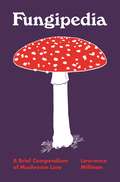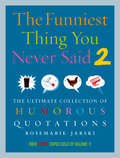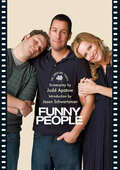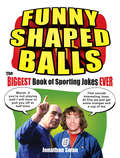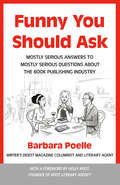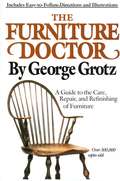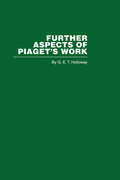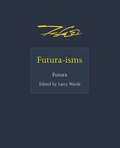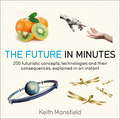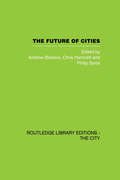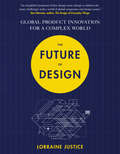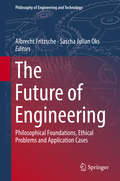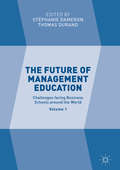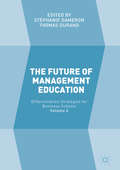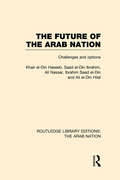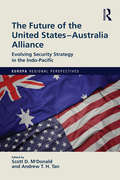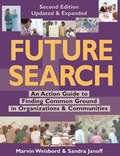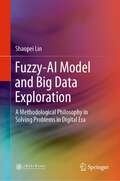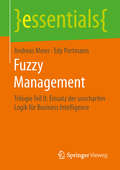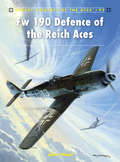- Table View
- List View
Fungipedia: A Brief Compendium of Mushroom Lore
by Fungipedia Lawrence MillmanAn illustrated mini-encyclopedia of fungal lore, from John Cage and Terrence McKenna to mushroom sex and fairy ringsFungipedia presents a delightful A–Z treasury of mushroom lore. With more than 180 entries—on topics as varied as Alice in Wonderland, chestnut blight, medicinal mushrooms, poisonings, Santa Claus, and waxy caps—this collection will transport both general readers and specialists into the remarkable universe of fungi.Combining ecological, ethnographic, historical, and contemporary knowledge, author and mycologist Lawrence Millman discusses how mushrooms are much more closely related to humans than to plants, how they engage in sex, how insects farm them, and how certain species happily dine on leftover radiation, cockroach antennae, and dung. He explores the lives of individuals like African American scientist George Washington Carver, who specialized in crop diseases caused by fungi; Beatrix Potter, creator of Peter Rabbit, who was prevented from becoming a professional mycologist because she was a woman; and Gordon Wasson, a J. P. Morgan vice-president who almost single-handedly introduced the world to magic mushrooms. Millman considers why fungi are among the most significant organisms on our planet and how they are currently being affected by destructive human behavior, including climate change.With charming drawings by artist and illustrator Amy Jean Porter, Fungipedia offers a treasure trove of scientific and cultural information. The world of mushrooms lies right at your door—be amazed!
Funniest Thing You Never Said 2
by Rosemarie JarskiThe bestselling, blockbusting, bumper book of humorous quotations rides back into town with 6,000 more hilariously funny quotes. From times past to the modern day, classic funnies to contemporary wit, The Funniest Thing You Never Said 2 delivers an unbeatable selection of fantastic and hilarious quotes on every subject under the sun. Featuring topics as diverse as celebrity to religion, and including a cast of quotees ranging from Oscar Wilde to Homer Simpson, there's something here for everyone with a sense of humour.'I am willing to love all mankind, except an American.' - Samuel Johnson'Glastonbury was very wet and muddy. There was trench foot, dysentery, peaches ... all the Geldof daughters.' - Sean Lock'Politics would be a helluva good business if it weren't for the goddamned people.' - Richard Nixon'I've had more women than most people have noses.' - Steve Martin'I have the simplest tastes. I'm always satisfied with the best.' - Oscar Wilde 'Well, it's 1am. Better go home and spend some quality time with the kids.' - Homer Simpson'All I know is I'm not a Marxist.' - Karl Marx'I'm the pink sheep of the family.' - Alexander McQueen
Funny People: The Shooting Script (Shooting Script)
by Judd Apatow Jason SchwartzmanIn Funny People, writer/director Judd Apatow finds humor in one of the biggest struggles of a person’s lifetime.Through the story of a famous comedian, George Simmons (Adam Sandler), who has a near-death experience, and what he does with a second chance, Apatow addresses a question that hasn’t been touched with such trademark bluntness: If you had the chance to start all over again, would you be the same jerk you always were? The film stars Adam Sandler, Seth Rogen, Leslie Mann, Eric Bana, Jonah Hill, Jason Schwartzman, RZA, Aziz Ansari, and Aubrey Plaza.
Funny Shaped Balls: The Biggest Book of Sporting Jokes Ever
by Jonathan SwanOver 2,000 sporting funnies from every sport: football, rugby, cricket, golf, boxing,snooker and beyond...Two men fishing on a river bank in a canal in London on a Saturday afternoon miles away from a radio or TV. Suddenly one man turns to the other and says, 'Spurs have lost again.' The other man is astonished and says, 'How on earth do you know that?' The other man replies, 'It's quarter to five.'After the success of the George Foreman grill, Audley Harrison is launching his own toaster. The problem is it can only do four rounds.What does Steve Harmison put in his hands to make sure the next ball almost always takes a wicket? A bat
Funny You Should Ask: Mostly Serious Answers to Mostly Serious Questions About the Book Publishing Industry
by Barbara PoelleThere is a certain perception from the outside that the publishing industry is a near insurmountable fortress, with gatekeepers and naysayers manning the turrets looking for any way to fire a flaming arrow at the dreams of an aspiring writer. Funny You Should Ask, based on the popular Writer's Digest column of the same name, assists to deconstruct, inform, and illuminate the path to publication and beyond, all while dispelling the rumor that those in the industry are better than thou. And even though each writer's publishing journey is like a game of PLINKO--you can drop the chip in the same slot every time and get a different result--there are still common constructs and confusions that can be shared and explored together in order to help inform all writers. From understanding the nuts and bolts of a query letter, to learning how to process the soul-searing envy of watching someone else's career flourish, to how to talk to your editor, veteran literary agent Barbara Poelle covers the approach and execution of the common and uncommon bumps along the traditional publishing path. Includes • More than 100 questions answered including expanded answers to topics that didn't get the full treatment in a column • Writing exercises, submission checklists, and publishing BINGO for every publishing milestone
Funnybooks
by Michael BarrierFunnybooks is the story of the most popular American comic books of the 1940s and 1950s, those published under the Dell label. For a time, "Dell Comics Are Good Comics" was more than a slogan--it was a simple statement of fact. Many of the stories written and drawn by people like Carl Barks (Donald Duck, Uncle Scrooge), John Stanley (Little Lulu), and Walt Kelly (Pogo) repay reading and rereading by educated adults even today, decades after they were published as disposable entertainment for children. Such triumphs were improbable, to say the least, because midcentury comics were so widely dismissed as trash by angry parents, indignant librarians, and even many of the people who published them. It was all but miraculous that a few great cartoonists were able to look past that nearly universal scorn and grasp the artistic potential of their medium. With clarity and enthusiasm, Barrier explains what made the best stories in the Dell comic books so special. He deftly turns a complex and detailed history into an expressive narrative sure to appeal to an audience beyond scholars and historians.
The Furniture Doctor: A Guide to the Care, Repair, and Refinishing of Furniture
by George GrotzThe best-selling guide to keeping furniture in the finest and most beautiful condition, with complete information on proper repair and refinishing techniques from the legendary expert on antiques and their restoration.B & W photographs throughoutFrom the Trade Paperback edition.
Further Advances in Pragmatics and Philosophy: Part 2 Theories and Applications (Perspectives in Pragmatics, Philosophy & Psychology #20)
by Alessandro Capone Marco Carapezza Franco Lo PiparoThe two sections of this volume present theoretical developments and practical applicative papers respectively. Theoretical papers cover topics such as intercultural pragmatics, evolutionism, argumentation theory, pragmatics and law, the semantics/pragmatics debate, slurs, and more. The applied papers focus on topics such as pragmatic disorders, mapping places of origin, stance-taking, societal pragmatics, and cultural linguistics. This is the second volume of invited papers that were presented at the inaugural Pragmasofia conference in Palermo in 2016, and like its predecessor presents papers by well-known philosophers, linguists, and a semiotician. The papers present a wide variety of perspectives independent from any one school of thought.
Fußspuren von Feist in der europäischen Datenbankrichtlinie: Eine rechtliche Analyse der Gesetzgebung zum geistigen Eigentum in Europa
by Indranath GuptaIm Zusammenhang mit der Rechtsprechung zur Urheberrechtsfähigkeit einer Tatsachenzusammenstellung werden in diesem Buch die Fußspuren des in einer Entscheidung des Obersten Gerichtshofs der USA (Feist) vorgesehenen Standards in Europa ausfindig gemacht. Insbesondere wird untersucht, inwieweit diese Rechtsprechung mit dem in der Europäischen Union angenommenen und diskutierten Standard übereinstimmt. Oftmals bleiben die Gründe für die Rechtsetzung unbemerkt. Die zwingenden Umstände und die Geschichte, die dem Erlass eines Gesetzes vorausgehen, helfen dabei, die Ausgewogenheit einer bestimmten Gesetzgebung zu verstehen. Bei der Betrachtung des Prozesses der Verabschiedung der Datenbankrichtlinie (96/9/EG) wird in diesem Buch über die Bedenken nachgedacht, die im Zusammenhang mit der Feist-Entscheidung in Europa geäußert wurden.
Futura-isms (ISMs)
by FuturaA collection of fascinating quotations from the legendary artist and graffiti pioneerFutura is a living legend—a world-renowned painter, designer, and photographer who was a pioneer of graffiti art and New York City’s “subway school.” His radical abstract work in the street and on canvas established him as a central figure in an important art movement that included Jean-Michel Basquiat, Keith Haring, Rammellzee, Lee Quiñones, and Dondi White. Futura-isms is a collection of essential quotations from this fascinating artist. Gathered from four decades of interviews and panel discussions, this memorable selection illuminates Futura’s thoughts on legal and illegal art, his influences, fellow artists, and the past, present, and future. He also offers colorful memories of his adventurous life—growing up in New York City, serving in the Navy, touring with The Clash—and reflects on how his experiences have shaped his art.Select quotations from the book:“Graffiti was a way for me to exist. I wanted the world to know my name. I wanted to be somebody.”“The essence of what graffiti is . . . is creating this identity and taking it to the public.”“My whole life, I think, I’ve been a nomad.”“I was always at home in the subway system.”“People say, ‘Let’s play within the rules.’ I say, ‘No—let’s break the rules a little bit.’”
The Future in Minutes (IN MINUTES)
by Keith MansfieldWhat does the future hold? How will we live, work and entertain ourselves? What new technologies will emerge? Will humanity evolve - and perhaps live forever? Or are we facing threats that could end us - and even the whole universe? The Future in Minutes tackles these and many other fundamental questions, concisely and lucidly explaining everything from cryptocurrencies and world governments to gene therapy and colonizing planets - and painting our options for utopia or disaster.Contents include: Predicting the future; How we'll live; Shifts in society; Technology of the future; Scarcity and solutions; Politics, warfare and ethics; The quest for immortality; Transhumans and posthumans; Artificial intelligence; Threats to humanity; Space travel and colonization; Super-advanced science; and The Fate of the Earth and the Universe.
The Future of Cities
by Andrew Blowers Chris Hamnett Philip SarreThis collection of readings draws on material from a wide range of sources - from the past and present and from literature and technology - and is concentrated on the areas which seem most relevant to the planning of the future city - what is happening to the city and what we can do about it. The readings have been selected and organised to present the planning of the future city. This book was first published in 1974.
The Future of Design: Global Product Innovation for a Complex World
by Lorraine JusticeHow can today's designers better engage with new and emerging technologies to take advantage of the opportunities these technologies can bring?"An insightful treatment of how design must change to address the many challenges with a world of global companies and design teams."--Don Norman, author, The Design of Everyday Things WHAT ARE THE 10 GLOBAL FACTORS THAT DETERMINE DESIGN SUCCESS?Using a wealth of examples from across multiple industries and countries, design expert Lorraine Justice fully explores the factors that will determine your success and provides a unique framework for navigating the industry into the future.You will learn how design and innovation are being impacted by new and emerging technologies, societal demands, cultural shifts, and broader world issues. The Future of Design is practical, concise and includes guidelines for building and supporting creative teams, advice and strategies for evaluating product concepts, and interviews with product designers, inventors, and innovators from around the world.
The Future of Engineering: Philosophical Foundations, Ethical Problems and Application Cases (Philosophy of Engineering and Technology #31)
by Albrecht Fritzsche Sascha Julian OksIn a world permeated by digital technology, engineering is involved in every aspect of human life. Engineers address a wider range of design problems than ever before, raising new questions and challenges regarding their work, as boundaries between engineering, management, politics, education and art disappear in the face of comprehensive socio-technical systems. It is therefore necessary to review our understanding of engineering practice, expertise and responsibility.This book advances the idea that the future of engineering will not be driven by a static view of a closed discipline, but rather will result from a continuous dialogue between different stakeholders involved in the design and application of technical artefacts. Based on papers presented at the 2016 conference of the forum for Philosophy, Engineering and Technology (fPET) in Nuremberg, Germany, the book features contributions by philosophers, engineers and managers from academia and industry, who discuss current and upcoming issues in engineering from a wide variety of different perspectives. They cover topics such as problem solving strategies and value-sensitive design, experimentation and simulation, engineering knowledge and education, interdisciplinary collaboration, sustainability, risk and privacy.The different contributions in combination draw a comprehensive picture of efforts worldwide to come to terms with engineering, its foundations in philosophy, the ethical problems it causes, and its effect on the ongoing development of society.
The Future of Home Health Care: Workshop Summary
by Victoria WeisfeldIndividuals with disabilities, chronic conditions, and functional impairments need a range of services and supports to keep living independently. However, there often is not a strong link between medical care provided in the home and the necessary social services and supports for independent living. Home health agencies and others are rising to the challenges of meeting the needs and demands of these populations to stay at home by exploring alternative models of care and payment approaches, the best use of their workforces, and technologies that can enhance independent living. All of these challenges and opportunities lead to the consideration of how home health care fits into the future health care system overall. On September 30 and October 1, 2014, the Institute of Medicine and the National Research Council convened a public workshop on the future of home health care. The workshop brought together a spectrum of public and private stakeholders and thought leaders to improve understanding of the current role of Medicare home health care in supporting aging in place and in helping high-risk, chronically ill, and disabled Americans receive health care in their communities. Through presentations and discussion, participants explored the evolving role of Medicare home health care in caring for Americans in the future, including how to integrate Medicare home health care into new models for the delivery of care and the future health care marketplace. The workshop also considered the key policy reforms and investments in workforces, technologies, and research needed to leverage the value of home health care to support older Americans, and research priorities that can help clarify the value of home health care. This summary captures important points raised by the individual speakers and workshop participants.
The Future of Management Education
by Stéphanie Dameron Thomas DurandThis book discusses the new challenges facing Business Schools around the world with potential scenarios that may be envisioned for 2030 and strategies for stakeholders. Based on documented descriptions of competitive dynamics in the 'business' of business schools in a variety of countries, the authors highlight the fact that the 'industry' of management education is going through major changes such as new governance and business models, mergers and acquisitions, internationalization of faculty and students coexisting with entrenchment in local markets, ever more needs for financial resources, development of distant and blended learning, and increasing pressure for research output to boost rankings. With concerns surrounding the sustainability of current trends in faculty salary inflation, social acceptability of higher fees, cost of distance learning and the risk of an academic-industry divide around knowledge produced by management research, The Future of Management Education develops an analysis of business models and institution regulation. The two volumes cover the context of Business Schools in ten countries and grapples with the challenges they currently face. They specifically discuss foresight scenarios and strategic implications for stakeholders (Deans, faculty, students, prospective students, alumni, local businesses, corporations, government, accreditation bodies).
The Future of Management Education
by Stéphanie Dameron Thomas DurandThis book discusses the new challenges facing Business Schools around the world with potential scenarios that may be envisioned for 2030 and strategies for stakeholders. Based on documented descriptions of competitive dynamics in the 'business' of business schools in a variety of countries, the authors highlight the fact that the 'industry' of management education is going through major changes such as new governance and business models, mergers and acquisitions, internationalization of faculty and students coexisting with entrenchment in local markets, ever more needs for financial resources, development of distant and blended learning, and increasing pressure for research output to boost rankings. With concerns surrounding the sustainability of current trends in faculty salary inflation, social acceptability of higher fees, cost of distance learning and the risk of an academic-industry divide around knowledge produced by management research, The Future of Management Education develops an analysis of business models and institution regulation. The two volumes cover the context of Business Schools in ten countries and grapples with the challenges they currently face. They specifically discuss foresight scenarios and strategic implications for stakeholders (Deans, faculty, students, prospective students, alumni, local businesses, corporations, government, accreditation bodies).
The Future of the Arab Nation: Challenges and Options (Routledge Library Editions: The Arab Nation)
by Khair el-Din Haseeb Saad el-Din Ibrahim Ali Nassar Ibrahim Saad el-Din Ali el-Din Hilal Roger OwenWhat is the place of the Arab states as a new world order emerges? How can the Arab world respond positively to change as the new Europe emerges, political relationships are restructured, and the information revolution transforms the global economy? To what extent are the Arab states in danger of falling prey to increasing disunity and fragmentation? The book is the result of a major research programme in which Arab social scientists outline some of the paths which could be taken by the Arab world over the next 25 years. It presents a detailed analysis of resources in the Arab world – including population, employment, oil and water supplies and the trade and investment situation. The authors argue for greater popular participation and reassert the argument that only by pooling resources effectively can the Arab states establish their place in a world of national and supra-national blocs.
The Future of the United States-Australia Alliance: Evolving Security Strategy in the Indo-Pacific (Europa Regional Perspectives)
by Scott D. McDonaldThe United States-Australia alliance has been an important component of the US-led system of alliances that has underpinned regional security in the Indo-Pacific since 1945. However, recent geostrategic developments, in particular the rise of the People’s Republic of China, have posed significant challenges to this US-led regional order. In turn, the growing strategic competition between these two great powers has generated challenges to the longstanding US-Australia alliance. Both the US and Australia are confronting a changing strategic environment, and, as a result, the alliance needs to respond to the challenges that they face. The US needs to understand the challenges and risks to this vital relationship, which is growing in importance, and take steps to manage it. On its part, Australia must clearly identify its core common interests with the US and start exploring what more it needs to do to attain its stated policy preferences. This book consists of chapters exploring US and Australian perspectives of the Indo-Pacific, the evolution of Australia-US strategic and defence cooperation, and the future of the relationship. Written by a joint US-Australia team, the volume is aimed at academics, analysts, students, and the security and business communities.
Future Search: An Action Guide to Finding Common Ground in Organizations & Communities
by Marvin Weisbord Sandra JanoffWhen the term ''future search'' appeared in Productive Workplaces (Weisbord, 1987), so many people sparked to it that we decided, after trying fancier names like ''strategic futures conference,'' to retain it. The response to the concept led to Discovering Common Ground (Weisbord et al, 1992), a work that pulled together principles and practices for value-based action planning. The earlier book presented a variety of high participation models and cases, most based on the Emery/Trist Search Conference, including early experiments with future search. In this book we focus on our evolving future search model. Here we go deeply into our sources and rationale, our experiments with tasks and techniques, and examples of how we and many colleagues have employed this model and its variations. We also provide a philosophical rationale for our design and facilitation practices. -amazon.com
Fuzzy-AI Model and Big Data Exploration: A Methodological Philosophy in Solving Problems in Digital Era
by Shaopei LinBased on the idea of a universal rule for problem solving, the book suggests that the “System-Fuzzy Approach (SFA)” Model can be applied to various complex real-world problems. It is the first book for problem solving in complicated problems with a universal project management tool. Systematic searching is an essential step in identifying the right direction in problem solving; and the fuzzy steps in concrete problem solving reflect the flexibility and compromises involved in the process. Nevertheless, the fuzzy steps also demonstrate human beings’ impressively flexible problem-solving skills. Simulating human decision-making processes based on fuzzy information processing is essential in our digital era, in which many problems need to be solved by means of artificial intelligence; hence the Fuzzy-AI Model emerged. As a universal rule and tool, it can be applied to a broad range of real-world problems. Offering a valuable guide to fuzzy decision-making, this book is intended for researchers, scientists and graduate students in the fields of Engineering, Economics, Sociology, Managerial Science, Project Management etc.
Fuzzy Management: A Fuzzy Grassroots Ontology For Online Reputation Management (essentials)
by Andreas Meier Edy PortmannAndreas Meier und Edy Portmann verwenden in diesem essential über Fuzzy Management die unscharfe Logik zur Lösung betriebswirtschaftlicher Probleme in der digitalen Wirtschaft. Die unscharfe Logik erweitert die klassische Logik mit den beiden Werten „wahr“ und „falsch“ und führt zu differenzierteren Beurteilungen. Neben Portfolio Management, Performance Measurement, Service Level Engineering und Reputationsmanagement wird die Business Intelligence mit weichen Faktoren angereichert, um den Entscheidungsprozess zu verbessern.
Fw 190 Defence of the Reich Aces
by John WealThis title is the natural conclusion to the collection of titles chronicling the exploits of the fighter pilots of the German Luftwaffe of World War 2 that has been part of - and contributed in some small measure to the success of - Osprey's long running Aircraft of the Aces series. Since the first appearance of Aircraft of the Aces 2 back in 1994, a further ten titles by various authors have been published on German fighters and their pilots. Together, these provide a comprehensive and unique overview of all the famous names (together with some lesser-known ones) who flew fighters 'for the other side' during the war . . . all, that is, except for one final category - those who were operationally on the Focke-Wulf Fw 190 in the defense of their own homeland during the later stages of the conflict from mid 1942 to May 1945. There has not been a work in either English or German - to the writer's knowledge - that deals specifically with this particular subject. Combining a selection of previously unpublished black and white photographs and color profiles, it admirably fulfills two roles - standing on its own, it provides something entirely new for the aviation historian and/or modeler, while as part of Osprey's Aircraft of the Aces collection, it closes the one remaining gap in the coverage of the Luftwaffe's World War 2 fighter pilots and their frontline operations.
Fylling's Illustrated Guide to Nature in Your Neighborhood (Fylling's Illustrated Guides #2)
by Marni FyllingIn the same lighthearted yet scientifically accurate style of Fylling’s Illustrated Guide to Pacific Coast Tide Pools, this portable guidebook reveals the splendidly strange animals and plants just outside your door. Marni Fylling’s full-color illustrations make species identification a snap, and concise descriptions include fascinating (and sometimes grotesque) factoids about frequently encountered plants, insects, arachnids, birds, and mammals. With Fylling’s guidance, the everyday becomes extraordinary: Pigeons share nest-building and egg-sitting duties, and mate for life—with occasional dalliances; squirrel teeth grow about six inches per year; spiders owe their characteristic creep to their &“hydraulic&” legs; poison oak and poison ivy’s itch-inducing oil is also found in pistachios, cashews, and mangoes; and much, much more.
